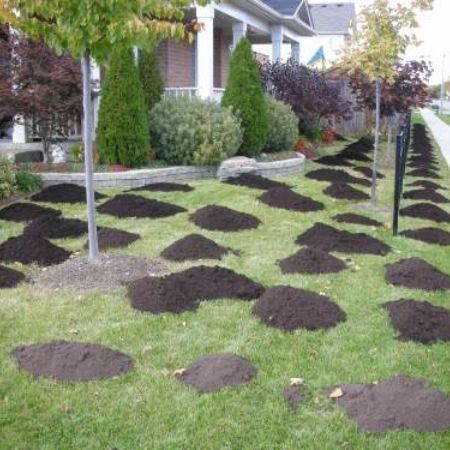How to Improve a Lumpy Lawn
- Milorganite AgronomistMay 12, 2022
There are many possible causes for the lumps, bumps, dips, and holes in your lawn. Eventually, every lawn will need a little leveling to remove the irregularities. Depressions in the soil may collect water causing drainage issues that can kill patches of lawn. Extremely uneven lawns can be dangerous, especially for children.

The first step is to identify the cause of the uneven terrain. Then, you can decide on the best treatment for a long-term solution. If you try to fix the problem without first identifying the cause, you may be wasting your time when the bumps or valleys return to your lawn.
Why is my lawn bumpy?
Here are some examples of why your lawn may be uneven:
- Uneven thawing in spring
- Heavy garden equipment
- Repeated mowing in the same pattern
- Pests, such as grubs and voles
- Children
- Weather
- Natural settling
Lawns Settle Over Time
Lawns naturally settle over time and with new construction, the lawn will most likely settle unevenly the first few years. Shallow or small areas can be fixed by topdressing the lawn. If the lawn has settled by one inch or more, you may need to remove the sod, back-fill, then return the sod.
Clay Soil
If you have clay-heavy soil and live where the soil freezes in winter, you may see new bumps and bulges in your lawn during the spring thaw. The clay soil causes heaving and buckling, which results from uneven thawing.
Clay soil will benefit from aeration, which breaks up the surface soil and redistributes it. This allows water and oxygen to more easily reach the roots. Topdress your lawn using quality topsoil or fine compost to level any remaining low-lying areas.

Animals, Children, Pests
Wild or domestic animals may be the culprit for low-lying areas. Dogs may enjoy digging for unknown treasures. Children and dogs playing or people simply walking across a soggy lawn can cause depressions, which may happen more easily on saturated spring soil.
Borrowing pests, such as moles or voles, can cause holes and small mounds. Chinch bugs and grubs can also be a problem. Address the pest issue first, otherwise, it’s just going to happen again.

Garden Equipment
Gardening equipment may cause holes and ruts. Repeatedly mowing your lawn in the same pattern can cause ruts to develop.
Spring: It’s the Best and Worst of Times
Spring provides the conditions grass likes—warm days and cool nights—which makes this season a good time to repair lumps and bumps. It can also be the worst time if the soil is soggy. You may be doing more damage than good walking on the lawn. Wait until the soil has had a chance to dry out.
How to Level Your Lawn
Topdressing with quality topsoil or compost could be your best solution for minor problems. Cut the lawn or affected area very short before topdressing. It’ll be easier to see the area and level the topsoil.
Apply no more than ½” at a time and gently level it without completely covering the grass. The grass will continue to grow through the topdressing. If a half-inch of soil isn’t enough, continue to topdress over several months until the area is level.
If a deeper, but small, hole is surrounded by a healthy lawn, you may be able to level the hole with soil and allow the grass to fill in. Larger areas will need to be seeded or patched with sod.
Watch this Video on How to Topdress Your Lawn with Compost
Rolling Your Lawn
Are you considering leveling your lawn using a roller? Here’s my advice: DON’T DO IT! It’s the worst thing you can do. It may seem logical, but the grass won’t grow in the heavily compressed soil created by leveling with a roller.
Prevention
The best way to help prevent lumps and bumps in your lawn is to keep it thick and healthy. Aerate regularly to loosen soil and allow more moisture and oxygen to reach the roots. Overseed to thicken lawns. Fertilize regularly using a nitrogen-rich fertilizer, such as Milorganite, to keep your grass lush and green. Stay on top of pest problems before they get out of control.
Lumps and bumps are natural. Determine what’s causing them before deciding on a long-term solution, not just a quick fix.

